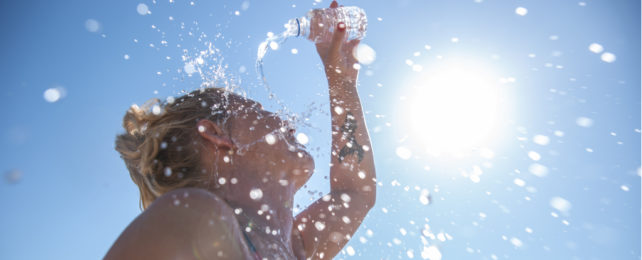It's unclear exactly where the myth that humans need to drink eight glasses of water a day came from – but we've probably all heard it at some point in our lives.
The evidence for this claim has largely been debunked. Past studies relied on people recalling how much water they drank, which has low precision.
To provide a more accurate estimate of how much water we actually need, a new study recruited over 5,600 people of all ages from 26 countries around the world.
Researchers gave participants 100 milliliters of water enriched with 5 percent 'doubly labeled water'.
Doubly labeled water is often used for metabolism experiments as it provides a way to track how rapidly chemicals are moving through the body.
This type of water contains unusual isotopes of hydrogen called deuterium. They have an extra neutron within their nucleus, making individual atoms twice as heavy as a normal hydrogen atom which has just one proton and no neutrons.
The resulting heavy water, which is 10 percent heavier than normal water, is safe to drink in small amounts.
To make it doubly labeled, this heavy water is also mixed with water containing an isotope of oxygen, Oxygen-18, which has 8 protons and 10 neutrons inside each atom (instead of the normal 8 of each). This is a stable, naturally occurring type of oxygen that makes up 0.2 percent of the air we breathe.
"If you measure the rate a person is eliminating those stable isotopes through their urine over the course of a week, the hydrogen isotope can tell you how much water they're replacing, and the elimination of the oxygen isotope can tell us how many calories they are burning," says Dale Schoeller, a nutritional scientist who co-authored the study.
The University of Wisconsin–Madison lab, where Schoeller works, first pioneered the doubly labeled water experiment in humans in the 1980s.
In their recent study, published in Science, the team shows that daily water intake varies greatly with age, gender, activity levels, and climate.
"The current study clearly indicates that one size does not fit all for drinking water guidelines, and the common suggestion that we should drink eight 8-ounce glasses of water per day (~2 liters) is not backed up by objective evidence," the researchers write.
Water turnover was greatest in men aged 20-30 and in women aged 20-55 and decreased after the age of 40 in men and after the age of 65 in women.
Newborns had the highest turnover of water as a percentage of all the water in their bodies – replacing around 28 percent every day.
Under similar conditions, men consume about half a liter more water every day than women.
For instance, a 20-year-old man who is not athletic, weighs 70 kg, and lives in a developed country at sea level with 50 percent humidity and a mean air temperature of 10°C will have a water turnover of around 3.2 liters per day.
A nonathletic woman of the same age living in the same location will have a water turnover of around 2.7 liters per day.
Using twice as much energy in a day increases the daily water turnover by about a liter.
For every additional 50 kilograms of body weight, water turnover increases by 0.7 liters a day.
A 50 percent jump in humidity pushes water use up by 0.3 liters.
Some people in the study had extremely high water turnover: 13 women who got through over 7 liters per day, they were either athletes, pregnant women, or experiencing warm weather, and nine men who consumed over 10 liters a day.
Once again these were highly active people, athletes, or Amazonian Ecuador foragers.
"The variation means pointing to one average doesn't tell you much," says Schoeller.
Water turnover increased for pregnant women in the third trimester of pregnancy and during breastfeeding.
People living a sedentary lifestyle in temperature-controlled indoor environments in developed countries had lower water turnover than people working as manual laborers or hunter-gatherers in developing countries.
"Improved guidelines are of increasing importance because of the explosive population growth and climate change the world currently faces, which will affect the availability of water for human consumption," the researchers write.
This paper was published in Science.
